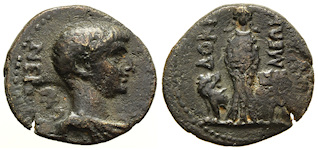Fine Coins Showcase
Antiquities Showcase
Show Empty Categories
Shop Search
Shopping Cart
My FORVM
Contact Us
About Forum
Shopping at Forum
Our Guarantee
Payment Options
Shipping Options & Fees
Privacy & Security
Forum Staff
Selling Your Coins
Identifying Your Coin
FAQs
zoom.asp
Home ▸ Catalog ▸ |Greek Coins| ▸ |Greek Countermarked||View Options:   | | | | | | A countermark is a stamped or punched impression adding elements of design to a coin after it was originally struck. The practice of countermarking coins was widespread throughout antiquity. It was particularly common in the provinces of the Roman Empire. Countermarks were applied to coins for many reasons, including revalidation, revaluation, devaluation, and propaganda. Exactly when and why any individual countermark was applied is often uncertain. |


According to Ptolemaic bronze expert Daniel Wolf, "These coins are attributed by Svoronos to Ake-Ptolemaïs (Acre), but modern finds indicate they are most likely from the area near (modern) Bodrum in Turkey." Bodrum was called Halicarnassus, Caria in ancient times and was famous for housing the Mausoleum of Mausolus, one of the Seven Wonders of the Ancient World.GP114040. Bronze obol, Lorber CPE B436; Svoronos 791; Weiser 79; BMC Ptolemies p. 54, 75; SNG Cop 476; Malter 102; Noeske -; Hosking -, Choice VF, near centered, green patina, highlighting earthen deposits, scratches, obv. edge beveled, central depressions, weight 10.403 g, maximum diameter 24.0 mm, die axis 0o, Caria (Halicarnassus?) mint, 246 - 222 B.C.; obverse diademed head of Zeus Ammon right; countermark: six-pointed pellet-star in a round punch; reverse ΠTOΛEMAIOY BAΣIΛEΩΣ (of King Ptolemy), eagle standing half left on thunderbolt, head left, wings closed, tripod in left field; scarce; $300.00 (€282.00)
Nero, 13 October 54 - 9 June 68 A.D., Docimeium, Phrygia


Cybele was born a hermaphrodite, but castrated by the gods, she became female. Heeding the Sibylline oracle the senate brought her worship to Rome in 204 B.C. as the first officially sanctioned Eastern cult. After approval, they were dismayed to learn that the priesthood required voluntary self-castration, which was abhorrent to the Romans. Romans were barred from entering the priesthood or even entering the priest's sanctuary. The eunuch priests, recruited from outside Rome, were confined to their sanctuary, leaving only to parade in the streets during festivals in April. Claudius removed the bans on Roman participation, making worship of Cybele and her consort Attis part of the state religion.RP113887. Brass AE 18, RPC I 3213.3 (same c/m); BMC Phrygia p. 191, 18 (same); Waddington 5954 (same); Hunterian II 2 = SNG Hunt I 2042 (same); c/m: Howgego 224, VF, well-defined countermark, dark patina, open edge crack, weight 3.064 g, maximum diameter 18.1 mm, die axis 0o, Docimeium (Iscehisar, Turkey) mint, c. 55 A.D.(?); obverse NEPΩN KAIΣAP, bare-headed draped bust of young Nero right, countermark: bearded bust left in an oval punch; reverse Cybele standing facing, between two lions, both turned away from her, but looking back in anticipation, ΔOKI/MEΩN divided in two upward lines above lions; $110.00 (€103.40)
Elagabalus, 16 May 218 - 11 March 222 A.D., Caesarea, Cappadocia


Kayseri, originally called Mazaka or Mazaca, is in central Turkey on a low spur on the north side of Mount Erciyes (Mount Argaeus in ancient times). During Achaemenid Persian rule, it was the capital of a Satrapy on the crossroads of the Royal Road from Sardis to Susa and the trade route from Sinope to the Euphrates. It was conquered by Alexander's general Perdikkas, was ruled by Eumenes of Cardia, then passed to the Seleucid empire after the battle of Ipsus. It became the capital of the independent Cappadocian Kingdom under Ariarathes III, around 250 B.C. During Strabo's time it was also known as Eusebia, after the Cappadocian King Ariarathes V Eusebes, 163 – 130 B.C. The name was changed again to "Caesarea in Cappadocia" in honor of Caesar Augustus, upon his death in 14 A.D. The city passed under formal Roman rule in 17 A.D. In Roman times, it prospered on the route from Ephesus to the East. Caesarea was destroyed by the Sassanid King Shapur I after his victory over the Emperor Valerian I in 260 A.D. At the time it was recorded to have around 400,000 inhabitants. Arabic influence changed Caesarea to the modern name Kayseri. The city gradually recovered and has a population of around 1 million people today. Few traces of the ancient city survive.RP112707. Bronze AE 27, Henseler 1062 (698d, notes otherwise unpublished var.), RPC Online VI T6703.26, Sydenham Caesarea p. 119, 522 (obv. leg. var.), F, dark green patina, some legend weak/off flan, porous, weight 12.451 g, maximum diameter 27.0 mm, die axis 315o, Cappadocia, Caesarea (Kayseri, Turkey) mint, 219 - 220 A.D.; obverse AY M AYPHΛIOC - ANTWNEINOC, laureate, draped, and cuirassed bust right, seen from behind; countermark: head of Helios right (?, obscure, uncertain) in a 4.4mm round punch; reverse MHTPOΠO - KAICAPIAC, agalma of Mount Argaeus placed on garlanded altar, ET Γ (year 3) in exergue; $80.00 (€75.20)
CLICK HERE TO SEE MORE FROM THIS CATEGORY - FORVM's PRIOR SALES



REFERENCES|
Page created in 1.032 seconds.








